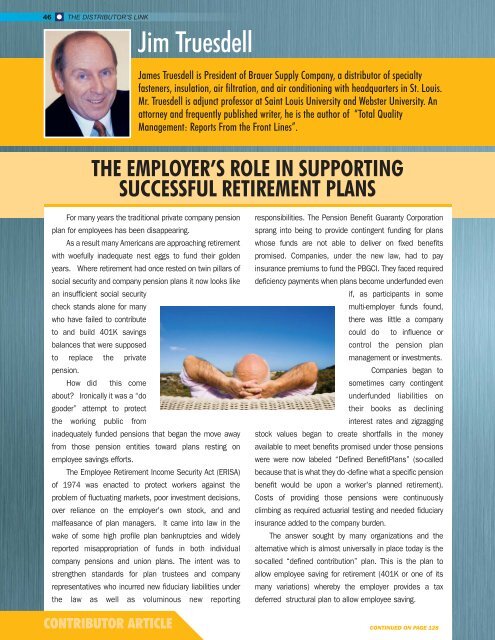WINTER 2016
Distributor's Link Magazine Winter Issue 2016 / Vol 39 No1
Distributor's Link Magazine Winter Issue 2016 / Vol 39 No1
Create successful ePaper yourself
Turn your PDF publications into a flip-book with our unique Google optimized e-Paper software.
46 THE DISTRIBUTOR’S LINK<br />
Jim Truesdell<br />
James Truesdell is President of Brauer Supply Company, a distributor of specialty<br />
fasteners, insulation, air filtration, and air conditioning with headquarters in St. Louis.<br />
Mr. Truesdell is adjunct professor at Saint Louis University and Webster University. An<br />
attorney and frequently published writer, he is the author of “Total Quality<br />
Management: Reports From the Front Lines”.<br />
THE EMPLOYER’S ROLE IN SUPPORTING<br />
SUCCESSFUL RETIREMENT PLANS<br />
For many years the traditional private company pension<br />
plan for employees has been disappearing.<br />
As a result many Americans are approaching retirement<br />
with woefully inadequate nest eggs to fund their golden<br />
years. Where retirement had once rested on twin pillars of<br />
social security and company pension plans it now looks like<br />
an insufficient social security<br />
check stands alone for many<br />
who have failed to contribute<br />
to and build 401K savings<br />
balances that were supposed<br />
to replace the private<br />
pension.<br />
How did this come<br />
about? Ironically it was a “do<br />
gooder” attempt to protect<br />
the working public from<br />
inadequately funded pensions that began the move away<br />
from those pension entities toward plans resting on<br />
employee savings efforts.<br />
The Employee Retirement Income Security Act (ERISA)<br />
of 1974 was enacted to protect workers against the<br />
problem of fluctuating markets, poor investment decisions,<br />
over reliance on the employer's own stock, and and<br />
malfeasance of plan managers. It came into law in the<br />
wake of some high profile plan bankruptcies and widely<br />
reported misappropriation of funds in both individual<br />
company pensions and union plans. The intent was to<br />
strengthen standards for plan trustees and company<br />
representatives who incurred new fiduciary liabilities under<br />
the law as well as voluminous new reporting<br />
CONTRIBUTOR ARTICLE<br />
responsibilities. The Pension Benefit Guaranty Corporation<br />
sprang into being to provide contingent funding for plans<br />
whose funds are not able to deliver on fixed benefits<br />
promised. Companies, under the new law, had to pay<br />
insurance premiums to fund the PBGCI. They faced required<br />
deficiency payments when plans become underfunded even<br />
if, as participants in some<br />
multi-employer funds found,<br />
there was little a company<br />
could do to influence or<br />
control the pension plan<br />
management or investments.<br />
Companies began to<br />
sometimes carry contingent<br />
underfunded liabilities on<br />
their books as declining<br />
interest rates and zigzagging<br />
stock values began to create shortfalls in the money<br />
available to meet benefits promised under those pensions<br />
were were now labeled “Defined BenefitPlans” (so-called<br />
because that is what they do -define what a specific pension<br />
benefit would be upon a worker's planned retirement).<br />
Costs of providing those pensions were continuously<br />
climbing as required actuarial testing and needed fiduciary<br />
insurance added to the company burden.<br />
The answer sought by many organizations and the<br />
alternative which is almost universally in place today is the<br />
so-called “defined contribution” plan. This is the plan to<br />
allow employee saving for retirement (401K or one of its<br />
many variations) whereby the employer provides a tax<br />
deferred structural plan to allow employee saving.<br />
CONTINUED ON PAGE 128

















